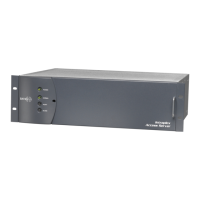ACS-160 Series & STL-160 Series T1 Multiplexer Installation & Operation 2 – Functional Description
Version 2.11, August 2011
2-12 Harris Corporation
Intraplex Products
2.1.4.4 Module Failure Detection and Switching
If module redundancy is enabled, detecting a failed primary module initiates a switch to the backup
module within 500 milliseconds of the failure condition. Module switching does not occur if
● Backup module is in a failed state.
● Backup module has been removed from the shelf.
● Module redundancy has been turned off.
If both modules have failed, service is interrupted. If one module has failed, a shelf alert is generated
if a successful switchover to the remaining good module has occurred. If a successful switchover has
not occurred (most likely due to module redundancy being turned off), a shelf alarm is generated.
As a general rule, a protection switch from the primary to the backup common module (CM) does not
cause a switch to the backup T1 line. The primary T1 line, connected to the MA-235-1 module
adapter, is redirected through the CA-202 cable and the MA-235-2 module adapter to the backup CM-
5RB module (Figure 2-9), ensuring that traffic remains on the primary T1 line independent of the
module-switching activity.
Figure 2-9. Signal Flow after Primary Module Failure
An exception to this general rule can occur if the primary and backup T1 facilities require different
interface settings for framing type, transmit line build-out, or T1 line code, as indicated by your
selecting the MLINE setting or by using the Front Panel User Interface (FPUI). In these rare situations,
the interface settings on the primary CM only works with the primary T1 line, and the settings on the
backup CM only work with the backup T1 line. To maintain proper interface operation in these cases, a
primary CM failure results in a switch of both the module and the line.
A module switch can be manually forced using either the front-panel switches on the Front Panel User
Interface or by issuing ISiCL commands. If the user manually forces a module switch, the system
switches back according to the normal protocols for reversion. For a permanent manual switch, set
module redundancy mode to OFF before the manual switch is initiated.
2.1.4.5 Module Redundancy Revertive Operation
You can configure module redundancy for revertive or non-revertive switching. This feature can be set
separately for line and module redundancy. If enabled, module redundancy reversion occurs as soon
as a working primary module replaces a failed primary module and the backup module’s channel

